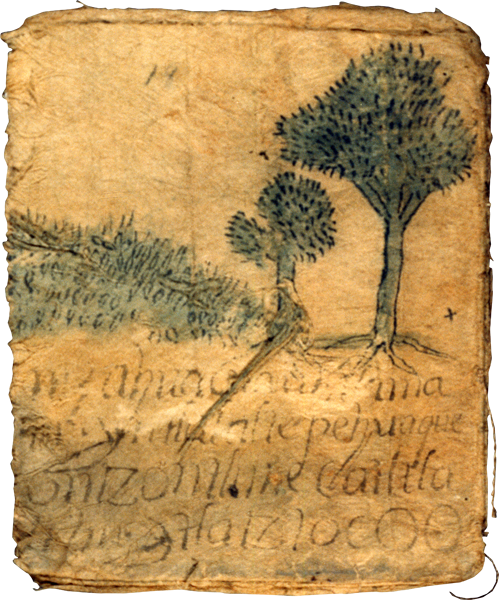entire face of one folio (pictorial and textual)
This page, which is the back side of the sixteenth folio of sixteen folios (also Book VII, folio 4 verso), is typical of the image-heavy pages that feature landscapes included in these territorial claims of Santa María Iztacapan (modern State of Hidalgo, Mexico) late in the Spanish colonial period.
This scene includes, on the left, a grass-covered slope and two trees (or a tree and a bush), with several lines of text on the bottom half of the page, followed by two circles. The slope is covered with long oval-shaped blades of grass outlined in black and washed with green. The whole slope is washed; not just the individual blades of grass. The tree or tall bush in the middle of the page is outlined in black and washed with the same green or blue-green. It has one clump of vegetation that is separate from the rest of the foliage. The taller tree is also outlined in black ink and washed with green. All the leaves are simple hash marks drawn in black ink. The roots of both trees appear above ground to some extent. The smaller tree appears to have one especially long root that stretches into the text area of the page. The larger tree may also consist of clumps of vegetation, but they run together. Three separate branches are visible where they meet the tree trunk, however. [SW]
Página entera de un folio
Esta página, la contratapa del decimosexto de dieciséis folios (también Libro VII, folio 4 recto), es la típica página cargada de imágenes que presenta paisajes incluídos en los reclamos territoriales de Santa María de Iztacapan (estado moderno de Hidalgo, México) a finales del período colonial español.
La escena incluye, en la izquierda, una pendiente cubierta de pasto y dos árboles (o un árbol y un arbusto) con varias rengoles de texto en la mitad inferior de la página, seguido de dos círculos. La pendiente está cubierta con hojas largas y ovaladas de pasto delineado en negro y coloreado en verde. Toda la pendiente esta coloreada con acuarelas, en lugar de cada pasto individualmente. El árbol o arbusto en el medio de la página está delineado en negro y coloreado con acuarelas verdes o azul-verdes. Tiene una copa de vegetación que está separada del resto. El árbol más grande también está delineado en tinta negra y coloreado en verde. Todas sus hojas son marcas de tinta negra. Las raíces de ámbos árboles están por encima de la tiera. El árbol pequeño o arbusto parece tener una raíz especialmente larga que se extiende hasta el área de texto de la página. El árbol más grande también tiene copas, pero están todas juntas. Si embargo, donde se encuentran el tronco podemos ver claramente tres distintas ramas.
